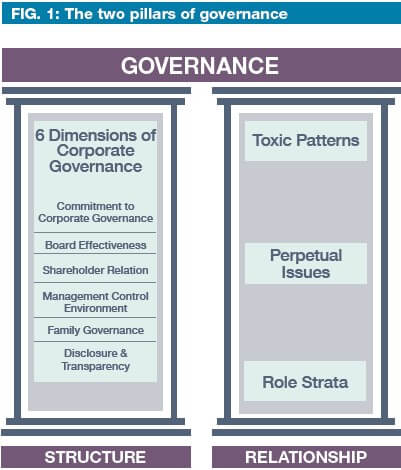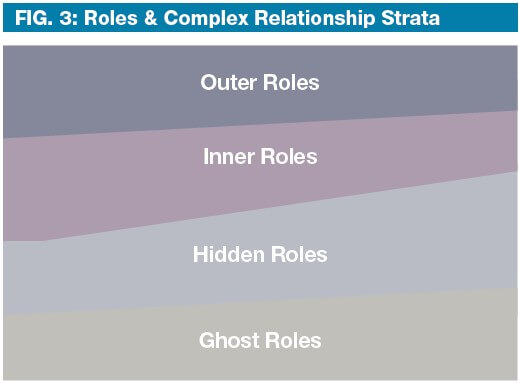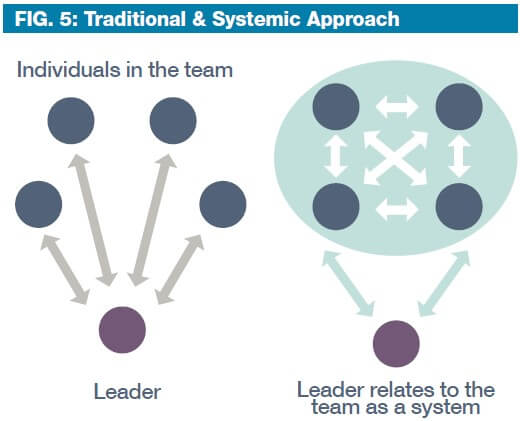
In order to run a successful family business, having a proper governance structure, high profits, and global brand recognition is not enough; none of these things matter once relationships between family members turn sour and conflict rears its ugly head. This article is based on Caroline Fakhoury’s research and work, coaching and advising family businesses in the region as well as on coaching and research done within Praesta firm over many years. Caroline is also a shareholder and board member of a centenary old family business conglomerate: Fattal Holding, Lebanon. Sharing deep knowledge of toxic communication patterns as well as perpetual issues, her article concludes that ultimately there is but one thing that will keep a family business from failing: love.
The 2 Pillars of Governance
The one thing that needs to be remembered from this article is that family businesses stand on 2 pillars: a structural one involving rules and formalities and a relational one involving feelings and behaviour. Both are the concern of what is called “governance.”
Because family businesses rely on relationships as well as structures, it is only when the principles of good governance become a living thing between people that they do add value and help create sustainability.
Family businesses should not make the mistake of focusing entirely on structural issues and theoretical best practices- they must also master the art of relationships and finding workable solutions for each unique family situation.
The focus of this article is on the relationship part of governance.
Communication, openness, the bonds of love and family duty; these dimensions can combine in a powerful way and can give family businesses a competitive advantage. However, the same forces can result in an unbalanced and problematic atmosphere within the family and the business. This is when people get hurt and value is destroyed. There are 3 main dimensions contributing to the dysfunction of family business relationships: Toxic communication patterns, perpetual issues, and the complexity of role strata (see Figure 1).
Toxic Communication Patterns
The chief threat for relationships are the four damaging patterns of communication that can poison the way family businesses operate. John M. Gottman, calls them the ‘Four Horsemen of the Apocalypse’. He states that these “…four disastrous ways of interacting…sabotage your attempts to communicate … In order of least to most dangerous, they are criticism, contempt, defensiveness, and stonewalling”.
The Four Horsemen are often referred to as poisons or toxic to highlight their destructive nature. Far too many relationships in family businesses deteriorate under their influence.
The First Poison: Criticism
Criticism tends to be applied in too general a manner and often seems like an attack on one’s whole personality and character instead of specific behaviour or problems.
For example, when a father says to his son, “You’re always late. You never call. You don’t care.” Often the pattern is that when complaints are ignored, dismissed and/or not voiced odds are high that criticism will infect the family and the business relationship.
These personal critical attacks of “You always…”, “You never…”, “You should…” and “You don’t care” put people immediately on the defensive.
The Second Poison: Contempt
Contempt is even more destructive to relationships than criticism. What separates contempt from criticism is the intention to insult and psychologically abuse the other person. With words and body language, the insult does not fail and goes straight to the heart of the other person’s sense of self”. Contempt can take many forms such as name calling, mean teasing, hostile humour, insults, mocking, ridicule, eye-rolling, shunning, looking away, sneering and so forth. All of these undermine the other person. For example, a statement of contempt could be, “You are such an idiot. I am really worried about seeing you managing this company one day.” As issues are left unresolved, anger escalates and contempt leads to more negativity and blame.
The Third Poison: Defensiveness
Naturally, family members tend to get defensive when insults are hurled at them and when they are being treated with contempt. So there is often a reaction to return anger for anger, blame for blame. Excuses are made or responsibilities denied. People reiterate their stance repeatedly instead of listening to the other. They play the victim and complain, and show it in their body language through a rigid stance or by turning away. Such defensiveness is ineffective as it leads to even poorer communication that drives away from developing solutions to problems. The fact that defensiveness is an understandable reaction to feeling besieged is one reason it is so destructive—the ‘victim’ doesn’t see anything wrong with being defensive. By being defensive family members are adding to the family’s troubles.
The Fourth Poison: Stonewalling
Family members tend to get so overwhelmed and eventually exhausted by such incessant criticism, contempt and defensiveness that they begin to shut down and stop responding.
Stonewalling often happens while two people are talking. The ‘stonewaller’ secludes himself by turning into a stone wall. The message to the other party is the same: “I am withdrawing, disengaging from any meaningful interaction with you”. When listening and interactions cease, conflicts become silent and hostile withdrawals. If this develops into a predictable pattern then the relationship is nearing its end. Once stonewalling becomes a regular resident, it takes a good deal of hard work and soul searching to save the relationship.
Perpetual Issues
The second challenge to family-owned business relationships is that conflicts fall into only two categories: the solvable and the perpetual.
Perpetual conflicts resurface over and over again. According to research, 69% of relationship issues are “perpetual” and are due to our on-going differences. No two individuals always think or act alike, family members have different preferences, ideas, perspectives, interests, and so on. These differences are normal, even in the healthiest and happiest relationships. The trick is to accept these differences, work with temporary compromises, and realise they probably will never disappear from the relationship as they come from fundamental differences in personality. They can be managed through dialogue and humour but cannot be “cured” or resolved.
In family businesses, this situation typically happens in times of generational transition and conflicts. The founder’s successor may not be as “perfect” and knowledgeable as he/she is, or see things in the same way. However, the heirs are most probably thinking the exact the same thing about the business founder. Since many issues are perpetual, the way forward is to solve “solvable problems” through “workable” rather than “perfect” solutions.
Roles & Relationship Strata
The third challenge in the complex fabric of family business relations is the layering of different roles inherent in family dynamics: we usually use the metaphor of geological strata. These roles can work in one’s favour or disadvantage.
Effective roles are critical to the smooth functioning of relationships. They create clarity about who is doing what. Roles become problematic when they become rigid or burdensome. Example: A family board member was perceived as occupying the “challenger” role in the board and frequently questioned the founder and the management’s decisions. Later, when this board member wanted to play the “peacemaker” role within the family system, he was locked in the “challenger” role and the expectations attached to it as Board members could not change their perception of him.
There are 4 different sets of roles constantly and continuously active within relationships. The 4 sets are what create the relationship strata.
Outer roles
The outer roles have to do with the external function. In organisations outer roles are often job descriptions: CEO, CFO, etc. Organisations depend on the quality of outer roles for successful operation. In family businesses outer roles include the founder, the heir or heiress, etc.
Inner roles
The inner roles have to do with the internal function and the emotional function. We are often unconscious of them: initiator, devil’s advocate, disturber, peacemaker, etc… Inner roles may not have anything to do with the actual job description of the individual but can be inherent to the character and the personality and can impact relationships deeply.
Example: A mother can play a peacemaker role in a fight between brothers over the family business inheritance.
Hidden roles
Individuals are not a single entity; they are many selves. The next strata down from Inner Roles are Secret or Hidden Roles. Secret roles are deep aspects of self. Secret selves are secondary identities, which live inside us. Examples are the wounded child, the playful daughter, the fearful son, the angry parent, the victim, the jealous wife, the ambitious cousin, etc. Secret selves can show up when people are triggered: suddenly our usual adult coping skills are gone, replaced by the hidden self who comes rushing up.
Example in a family business context, instead of a CFO and a CEO having a discussion, you have 5-year old and 12-year brothers having a fight.
Ghost roles
Ghost roles are invisible third party presences that come and go and impact the emotional environment. In a family business context, a “ghost” could be the memory of a late founder who is still remembered and whose presence is still felt in the organisation. It could also be a son that has resigned from the business out of frustration but whose absence (“ghost”) is still felt in the board.
These roles can be constructive or destructive and sometimes they need to be changed when symptoms occur; it is important to catch the signals that outer and inner roles have become outdated or problematic. There are several kinds of role issues.
Role fatigue
Role fatigue occurs when someone becomes sick or tired of playing the same role. Being forced to hold the same role for long periods of time becomes claustrophobic.
Example: A son waiting for years for the founder to let go and pass the baton.
Role confusion
Role confusion occurs when people are unclear about what roles they are meant to play. Example: when job descriptions are not clear between the founder and the newly appointed CEO.
Poorly occupied roles
Poorly occupied roles occur when the person occupying a role is bad at it. Example: An erratic and incapable brother occupying a leadership position in the family business.
Need for new role
The need for new roles occurs when developmental changes in families or organisations require the need for new roles not yet present. In family businesses, it is typically the case in succession times when new roles emerge. For leadership to transition from one generation to another, roles have to change-and this isn’t easy.
Surviving Generational Transitions
95% of family businesses do not survive the third generation of ownership. This usually happens when the 2 pillars of governance are neglected. Poor or no corporate governance is in place and the family and the company are faced with: difficult generational transitions, the complex web of relationships and roles, poisonous communication, and perpetual issues.
When your shareholder is your father and your employee is your nephew you cannot avoid emotions.
Adopt a Traditional & Systemic Approach
Two antidotes to the poisons and complexities mentioned above are the systemic approach and the constructive communication ratio.
The first antidote is adopting a “systems approach”. It is often used to raise awareness among all the players about how they are relating to each other and how it impacts the business. A system is an ordered composition of elements in a unified whole and the whole is more than the sum of its parts. Members of a family system interact in reciprocal relationships, responding to one another in the context of roles. The central thesis of systems theory is that, in order to understand the family system, the whole system must be considered, rather than breaking the system down into its parts.
It is similar to the experience on a sports team, with a choral group or on a project team where individual egos are melted into something much greater and true. As a system, the family exists in paradox. It needs stability so that family members know their roles and can carry them out with the security that they are «doing it right.» Stability provides continuity over time. At the same time, the system needs to be able to adapt to the changes in and among family members. The result is a balancing act. If there is too much change, the system breaks down; if too much stability the system atrophies and dies away.
Looking at the family from this perspective, it is fundamental to build powerful dialogue and to avoid toxic communications styles. Family members and professionals can use their ability to move from seeing a group of individuals to seeing the system itself as a living breathing entity:
Family business Chairmen must see the conflict not as a problem but as a signal that change is needed in the system. It is not about “who is doing what to whom; it is about what is trying to happen”.
Family Business CEOs must have the ability to read the “emotional field” of the system and accurately identify the emotional climate in a given situation. Once the system is revealed to itself it can begin to self-correct.
All the voices in the relationship system have to be heard, including unpopular ones, as they are part of the knowledge pool of the system.
Everyone is a voice of the system. The ability to shift from a personal perspective (“it’s Malek’s opinion”) to a systems perspective is key (“Malek is expressing something that lives in the system and it’s not personal”).
The Constructive Communication Ratio
The second antidote to dysfunctional relationships is to abide by the constructive communication ratio. Whilst the first antidote might be difficult to implement without help, this one can be easily applied.
It all comes back to what is a balanced ratio of constructive interactions during conflict (asking questions, being kind, being empathetic) versus challenging interactions (criticism, hostility, anger, hurt feelings)? Research has shown that the ratio of encouraging-to-challenging, in relationships that last, turns out to be 5:1. It is an interesting equation! If a family member gives 1 negative comment, he/she has to make up for it 5 times with positive comments.
It is not a balanced equation: The negative or threatening has more ability to inflict pain and damage than positive/affirming things have to heal.
Finally
This article has provided some tools to creating long term and sustainable family business relationships. However, if things are tangled and this seems like the time to ask for help to get there, then make a commitment now to look for the kind of practical, professional advice that will benefit your family and your family business and yourself for years to come.
It is important to remember, it is a truism — and it is well known that: “There is often more conflict within business families than is ever seen from outside.” But it is also true that: “There is often more love within business families than they themselves remember when they are focused on the work at hand.” In summary, it is of absolute importance to remember that love, and to use that love to keep the toxicity out of the family relationships. Keep blame, defensiveness, contempt, and stonewalling out of the boardroom, out of the bedroom, out the family council, and out of the leadership team.
That way, family members can relax and enjoy Friday lunch together. That way they can enjoy the opportunities, and the profits, and the security together!
Tharawat Magazine, Issue 11, 2011





















